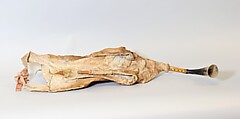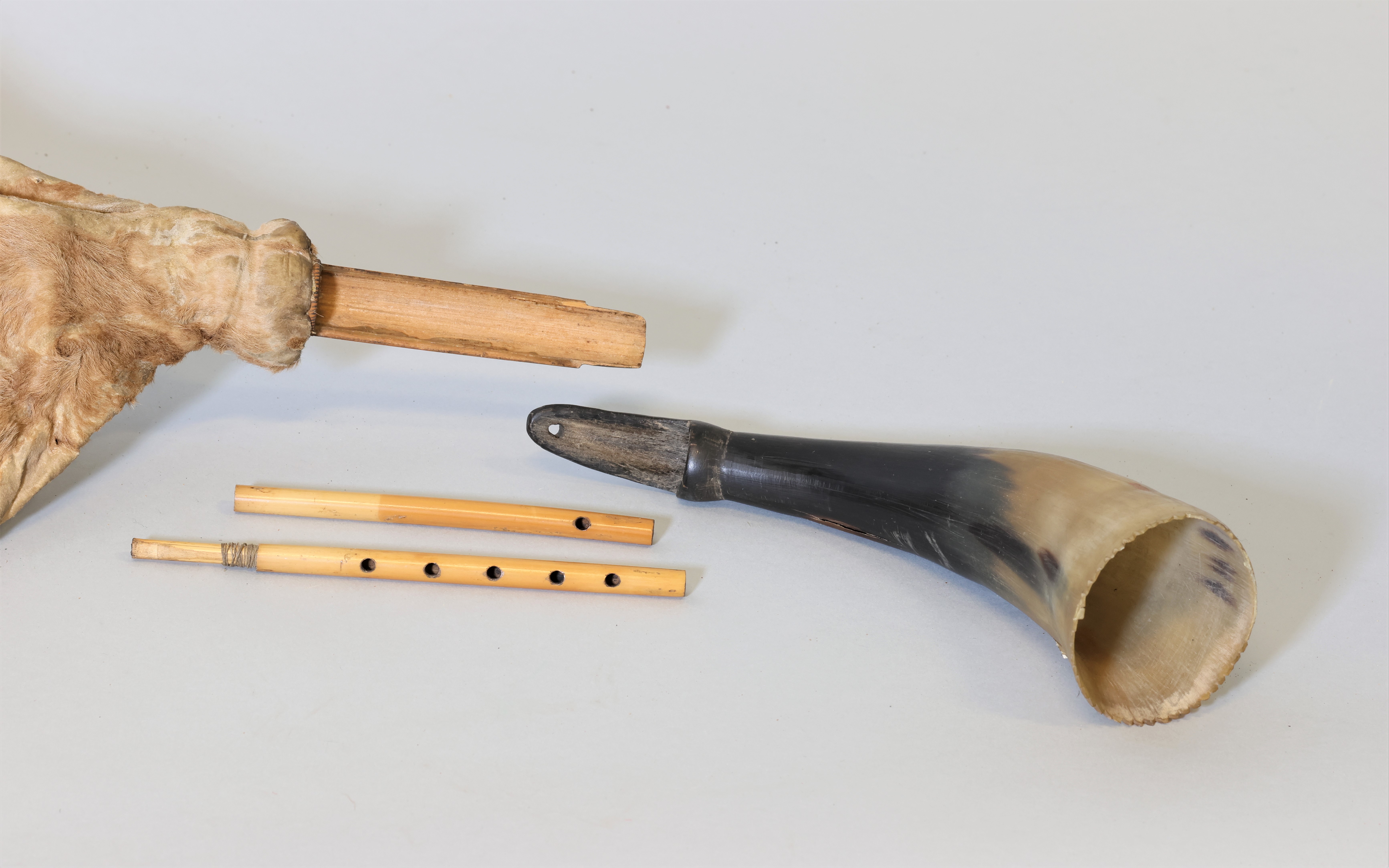Żaqq
Not on view
The żaqq is the bagpipe from Malta, a small island in the Mediterranean. Mostly associated with Christmas time and festive days, the bagpipe was played either as a solo instrument or, more often accompanied by it-tanbur, a frame drum with membrane on one side and with jingles inserted into the frame. Several nineteenth century depictions show the two in a gyrating dance while performing (Partridge 2019).
A particularity of the żaqq is that the bag is made out of the entire skin of an animal, including the hind legs and tail. Bags were traditionally made out of calf, dog or goat skin. The bag of this żaqq is probably made out of the skin of a Kelb tal-Fenek (Pharaoh hound), with fur-side out, including legs and tail (Borg Cardona 2020). Three legs and all other holes are tied on the inside. The bag is stiff, there is no sewing and no attempt to conceal the animal skin. Ribbons on the hind legs constitute the only decoration.
A cane insufflation pipe (l-imserka) is inserted and tied into the right foreleg. Since there is no non-return valve, the insufflation pipe would have been blocked with the tongue when necessary. The chanter (is-saqqafa), fitted and tied firmly into the neck, consists of two cane pipes with cylindrical bores (il-qimi) arranged side by side within a cane yoke/stock. It features five fingerholes on the right melodic pipe and one on the left pipe, used as a drone. There is only one surviving down-cut reed (il-bedbut) in the right melodic pipe. The two pipes are cradled into the wider cane yoke (qasba ħoxna/qxejra) and terminate in one large cattle horn (il-qarn) with a serrated outer edge.
The instrument forms part of the Crosby Brown collection. In April 1887, Mary Elizabeth Crosby Brown was already inquiring about Malta’s instruments. This bagpipe eventually reached her on 20 December 1900 and entered the Metropolitan Museum’s collection together with all the other instruments she donated. The first official catalogue of this bagpipe was prepared by Miss Frances Morris under the direction of the donor Mary Elizabeth Crosby Brown (Brown 1904). This instrument is understood to be the oldest surviving example of a Maltese bagpipe (Borg Cardona 2020).
(Anna Borg Cardona, 2023)
Technical description
2 cane pipes with cylindrical bores, R. 5 holes; L. 1 hole. (It is more common in Malta to have the two pipes inverted R. 1 hole, L. 5 holes. The lower fingerhole of the pipe with 5 holes is left unfingered and used as a vent hole.)
Left chanter acting as drone
1 extant single down-cut reed in Right pipe.
Second reed missing. This reed which was present in the 1904 catalogue was missing in the 1977 catalogue.
Cane yoke
Cane insufflation pipe
Horn bell, serrated on its outer edge
References
The Crosby Brown Correspondence, Metropolitan Museum of Art, New York.
Brown, Mary Elizabeth, 1904. Catalogue of the Crosby Brown Collection of Musical Instruments of All Nations 1, Europe. The Metropolitan Museum of Art Handbook, no.13. New York: Metropolitan Museum of Art.
Partridge, J.K. and Frank Jeal, 1977. “The Maltese Żaqq” Galpin Society Journal 30, 112-144.
Partridge, J.K., 2019 Quest for the Maltese Żaqq. Malta: National Archives of Malta & Midsea Books.
Borg Cardona, Anna, 2020 "A Nineteenth-Century Maltese Bagpipe in the Metropolitan Museum Collection" Journal of the American Musical Instrument Society, 78-98.
Due to rights restrictions, this image cannot be enlarged, viewed at full screen, or downloaded.
This artwork is meant to be viewed from right to left. Scroll left to view more.





